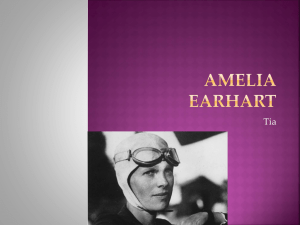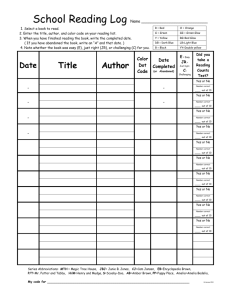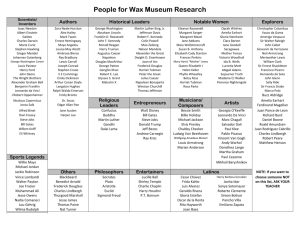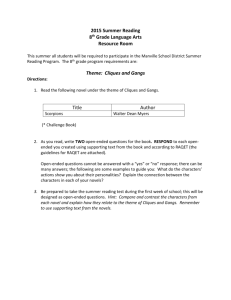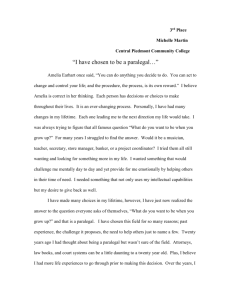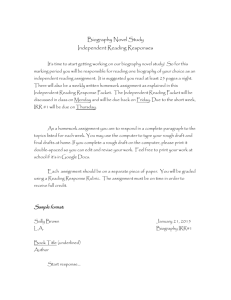Analisa Alvarez Electronic note cards March 23rd 2010 Source
advertisement
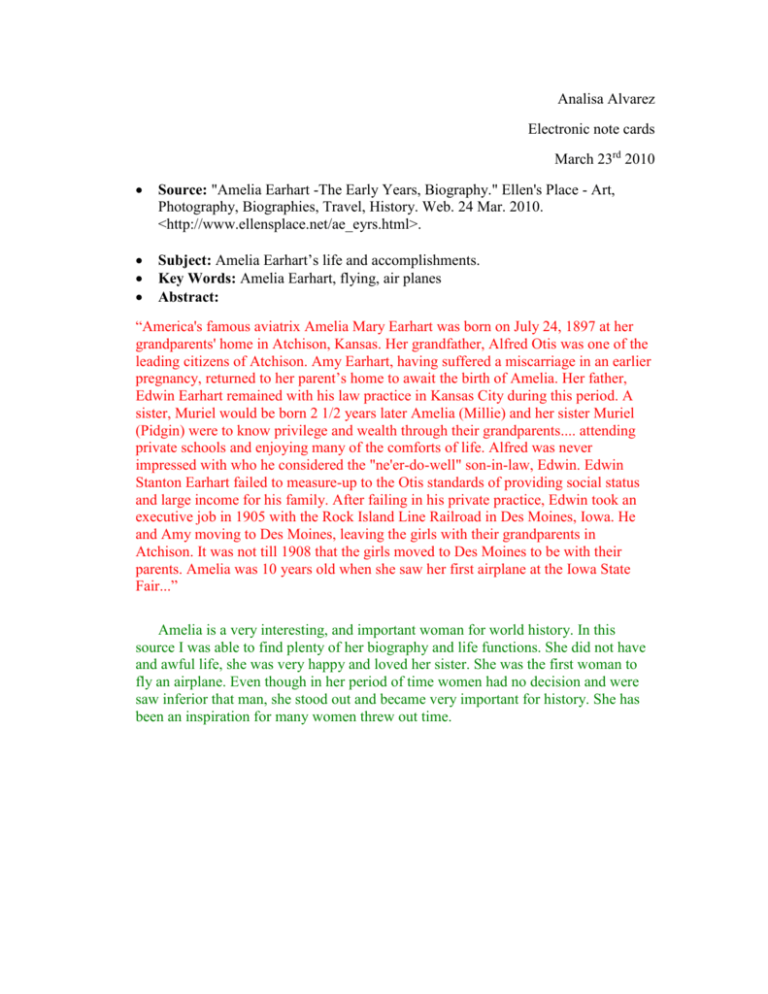
Analisa Alvarez Electronic note cards March 23rd 2010 Source: "Amelia Earhart -The Early Years, Biography." Ellen's Place - Art, Photography, Biographies, Travel, History. Web. 24 Mar. 2010. <http://www.ellensplace.net/ae_eyrs.html>. Subject: Amelia Earhart’s life and accomplishments. Key Words: Amelia Earhart, flying, air planes Abstract: “America's famous aviatrix Amelia Mary Earhart was born on July 24, 1897 at her grandparents' home in Atchison, Kansas. Her grandfather, Alfred Otis was one of the leading citizens of Atchison. Amy Earhart, having suffered a miscarriage in an earlier pregnancy, returned to her parent’s home to await the birth of Amelia. Her father, Edwin Earhart remained with his law practice in Kansas City during this period. A sister, Muriel would be born 2 1/2 years later Amelia (Millie) and her sister Muriel (Pidgin) were to know privilege and wealth through their grandparents.... attending private schools and enjoying many of the comforts of life. Alfred was never impressed with who he considered the "ne'er-do-well" son-in-law, Edwin. Edwin Stanton Earhart failed to measure-up to the Otis standards of providing social status and large income for his family. After failing in his private practice, Edwin took an executive job in 1905 with the Rock Island Line Railroad in Des Moines, Iowa. He and Amy moving to Des Moines, leaving the girls with their grandparents in Atchison. It was not till 1908 that the girls moved to Des Moines to be with their parents. Amelia was 10 years old when she saw her first airplane at the Iowa State Fair...” Amelia is a very interesting, and important woman for world history. In this source I was able to find plenty of her biography and life functions. She did not have and awful life, she was very happy and loved her sister. She was the first woman to fly an airplane. Even though in her period of time women had no decision and were saw inferior that man, she stood out and became very important for history. She has been an inspiration for many women threw out time. Electronic card #2: Source: "Amelia Earhart Remembered for Her Strength | Amelia Earhart." The Official Website of Amelia Earhart. Web. 24 Mar. 2010. <http://ameliaearhart.com/news/2009/11/amelia-earhart-remembered-for-herstrength/>. Subject: life of Amelia Earhart, strength and last flights. Key words: last flight, her death, and career. Abstract: “Amelia Earhart was a strong, successful woman and really a pioneer for women. She never allowed anyone to tell her she could not accomplish what she had put her mind to. As most everyone knows Amelia is known for her dedication to flying and her final flight. The last flight she ever took was attempting to fly around the world. She knew that no one had ever successfully done it, but she just figured she’d be the first. She disappeared during her trip never to be heard from again, but that single attempt made her a role model for young girls for years to come. In 1932, she was the first woman to ever fly solo across the Atlantic Ocean. In addition, she was the first female to ever receive the Air force Distinguished Flying Cross. Only a few women preceding her have been able to receive the same honor. Amelia is easy to identify with her cropped hair, which was almost unheard of at that time, tomboy appearances, and usually always pictured around an airplane or on a runway. She also always had on a leather flight jacket, which would keep her warm during flights in her small aircraft. Airstrips, also known as the runway, were not the only things she was known for during her time period.” Amelia, was always seeking for her goals, and accomplished them. She was an inspiration to many people. In one of her flights or may I say her last flight was the cause of her death. She was the first woman to cross the Atlantic Ocean and won prices for it. She was a very perseverant woman with a strong character that made her succeed! This source is going to be very useful for me. Electronic Card #3 Source: Eric, Niderost. "American History." Amelia Earhart Biography. N.p., 28/8/09. Web. 14 Apr 2010. http://americanhistory.suite101.com/article.cfm/amelia_earhart_biography Subject: Amelia’s records, as a celebrity, and her competition Key words: number of records, celebrity, competition Abstract: “In 1928 book publisher and publicist George Palmer Putnam and some associates were looking for a woman to go on a planed flight across the Atlantic. Putnam heard of Earhart, and when he interviewed her he was struck by her resemblance to aviator Charles Lindbergh. Amelia was picked, and accompanied pilot Bill Stultz and copilot “Slim” Gordon on the “Friendship” flight across the Atlantic in a Fokker F-7. It was a dangerous undertaking—several people, including three women—had died making the attempt. But the Friendship airplane reached Wales in Europe in 21 hours. Amelia became an instant celebrity, her fame even eclipsing her two male companions Amelia was gracious, but unhappy with herself. She had only been a passenger on the flight, in her words, a ‘sack of potatoes.” Earhart wanted to prove she was worthy, to the public and to herself. In 1931 Amelia married George Palmer Putnam. Did she love him, or was it more of a “working” relationship? The subject is still debated. But in 1932 she crossed the Atlantic solo, the first woman and only second person (after Lindbergh) to do so. As the years passed Amelia broke a number of records. including altitude records. In 1935 she became the first person to fly the 2,408 miles from Oakland, California to Honolulu, Hawaii. She also campaigned passionately for equal rights for women, and had among her friends Eleanor Roosevelt. But Amelia the celebrity started to become a drag on Amelia the woman and pilot. In part to finance her flights, and in part to maintain their almost “Hollywood” lifestyle, Putnam had Amelia go on grueling lecture tours and public appearances. She endorsed various products, and had her own clothing line and “signature” luggage. Amelia was often exhausted, battling stomach problems and her old enemy, sinusitis. If that wasn’t bad enough, it seems she didn’t practice enough to be a truly good flyer. Bobbi Trout, another women pilot of the era, says in a PBS documentary that you needed to fly every day to maintain skills. Amelia, perhaps, spent too much time on lecture tours and publicity.” Through the years Amelia started to break many records around the world. She started to become a very big celebrity because of all of her amazing achievements. Amelia was not the only women that started to flight, later on more women started to fly. There was obviously competition started to grow within her career. Many people thought that since she was always on tours and being a celebrity was affecting her because she needed to practice every single day to be the best. Electronic Card #4 Source: Delmore, Lauren. "Jiskha Homework Help." Jiskha. N.p., n.d. Web. 14 Apr 2010. <http://www.jiskha.com/social_studies/people/earharta.html>. Subject: Amelia’s problems, all of her influences and her impacts Keywords: Problems, Influences, Impacts Abstract: “There were a few problems that Amelia faced in her life. One problem was that her dad had developed a serious drinking problem, in which he could not keep a steady job. An effect from this is that their family had to move a lot. They lived in many places, including Kansas City, Des Moines, St. Paul, and Chicago. This also effected Amelia because she had attended six high schools before graduating, had to break off friendships, and had missed some things by not staying in one place for a long time. Amelia had one benefit from this and that was that she learned to adapt to new surroundings quickly. This influenced her development because she learned that her father's drinking problem was very bad, and not healthy. Amelia faced her problems very wisely. Her other problem was criticism. People always considered women as "different". Women also had to prove their ability constantly, and were not taken seriously. She always said to herself that she was not afraid to fail, would refuse to accept boundaries set by society, and would never give up. She overcame this problem by becoming the first woman to fly across the Atlantic Ocean solo, in which she became even more confident. She wanted to set new records. She eventually accomplished that by becoming the first woman to fly solo across the Pacific Ocean. She also attempted to fly around the world in the hardest direction, along the equator. At the end of her attempt she was lost in the Pacific Ocean. The influences on Amelia's life were very important. One person who influenced Amelia's life was Charles Lindbergh. Charles Lindbergh made the first solo flight across the Atlantic in 1927. This impressed Amelia and she hoped to someday make the first woman solo flight across the Atlantic Ocean. She accomplished this, along with a record of being the first woman to fly solo across the Pacific, and attempting to fly around the world. Her flight across the Atlantic took thirteen and a half hours from Harbor Grace, Newfoundland to Londonderry, Ireland. Her Pacific flight was from Hawaii to Oakland, California. Charles had a positive effect from the influences on Amelia's decisions to never give up in her life. The impacts on Amelia's life were also very important. Amelia's dad's drinking problem was an impact on Amelia's life. There was a negative and positive effect. The negative effect was how it effected her family's development, especially since he could not keep a steady job. Not being able to keep a steady job cost them a lot of money. The difficulties with the money had to do with why they had to keep moving. The positive effect is the benefit of adopting to new surroundings. Another impact on Amelia's life was when she went to visit her sister in Canada during the war. When she saw all of the wounded soldiers, she felt that she needed to help. She quit college to become a nurse for the Red Cross. Working as a nurse during the war also had an impact because she met many pilots. The pilots told her about flying planes and she became very interested. This had a positive effect because she later became a pilot and set records for women.” Amelia went through lots of problems as a kid, her dad had a very big drinking problem which had a bad influences. Since her dad was not had a steady job they were moving around place to place every time, and she needed to adapt to this type of living over the years. Amelia before being a pilot helped the military by being a nurse, there she meets lots of pilots and that’s how she started to get interested on the planes. Also she was influenced by a great man named Charles Lindbergh which was the first men to go through the Atlantic on his own. Electronic Card #5 Source: "Kansas State Historical Investigation." Kshs. N.p., n.d. Web. 14 Apr 2010. <http://www.kshs.org/people/earhart_ameliatimeline.htm>. Subjects: Amelia’s achievements and important events timeline Keyword: Timeline Abstract: “ 1897 - Born Atchison, Kansas, July 24. 1915 - Graduated from Hyde Park High School Chicago. 1916 - Studied at Ogontz School at Philadelphia. 1918 - Worked as a Nurses' Aide under the Canadian Red Cross. 1919 - Went to New York and matriculated for medicine at Columbia University. 1920 - Joined her parents in Los Angeles and trained for aviation at Rogers Airport. After but ten hours instruction, she made her first solo flight. During this time she worked in a telephone office, worked in a photograph studio and did trucking to earn money for her flying expenses. Bought a second-hand plane. 1926 - Attended Harvard Law School. Took up social service work and was connected with Denison House in Boston. Was later elected to the board of directors. 1928 - Was one of the five incorporators of Denison Aircraft Corporation that established a commercial airport at Squantum. Was invited to join Wilbur Stultz, pilot, and Louis Gordon, mechanic, in a flight across the Atlantic. Took off from the Jeffry Yacht Club moorings of East Boston on June 3. Flew to Newfoundland and took off from Trespassey, June 17, and 20 hours, 40 minutes later landed at Burry Point, Wales. Published 20 Hours and 40 Minutes. 1928 - July 3-Became a member of Boston Zonta Club, under classification of social worker. 1929 - Became vice president of the New York, Philadelphia and Washington Airways Corporation, and president of the Boston chapter of the National Aeronautic Association. 1930 - Aviation Editor of Cosmopolitan Magazine. 1930 - May-Became member of Zonta Club of New York City, this time under Aeronautical classification. 1931 - Married Publisher George Palmer Putnam on February 7. Published The Fun of It. 1932 - Flew alone across the Atlantic May 20-21, the first woman to do so, in 13 hours, 30 minutes--a new trans-Atlantic record. This flight was made from Harbor Grace, Newfoundland, to near Londonderry, Ireland. For this achievement she was made a Chevalier of the Legion of Honor of France; was the first woman to be awarded the Distinguished Flying Cross, and received the gold medal of the National Geographic Society. Made her first autogiro flight, and later made the record altitude flight in this plane. 1935 - In January became the first woman to fly from Hawaii to Oakland. In May she flew non-stop from Mexico City to New York City in fourteen hours, nineteen minutes. 1936 - Became a traveling faculty member and aeronautics and career advisor at Purdue University. 1937 - In March, accompanied by Fred Noonan, navigator, she started on a flight around the world. Flew from California to Hawaii but crashed at Honolulu as she was taking off on a second leg of the trip. Returning to the United States, she prepared for another attempt on June 1. She flew south from Miami and landed at San Juan, Puerto Rico, Dutc h Guiana, Brazil; across the Atlant ic to the Red Sea, along the Arabian Coast to India; across India Calcutta, Rangoon, Singapore, Java, Port Darwin, Australia, to Lae, New Guinea. From Lae she took off for Howland Island. The Coast-Guard cutter, Itasca, attempted establish radio contact with her plane, but because of a difference of frequencies the Itasca radioman was unable to give her bearing. The greatest search party in flight history was sent out, but no trace was ever found of the plane or fliers.” The timeline on Amelia Earhart will help me specificly in the summery part of the project. In details there are very important dates that are arranged in order so that it can be easier. With the timeline I will be able to know every single thing about her life. Electronic Card #6 Source: "Amelia Earhart last flight." Unmuseum. N.p., 1999. Web. 14 Apr 2010. <http://www.unmuseum.org/earhart.htm>. Subject: Amelia’s strange disappearance, researches and theories Keywords: Search, theories, Last flight Abstract: Investigations into the disappearance of Amelia Earhart and Fred Noonan “Investigations into the disappearance of Amelia Earhart and Fred Noonancontinue even today. TIGHAR (The International Group for Historic Aircraft Recovery) has an active project trying to determine if the Electra might have gone down on of a collection of islands called the Phoenix Group which lie on the same line-of-position as Howland. If the Electra had missed Howland and turned onto that line heading in a southwardly direction, it might well have reached one of the small islands of Baker, McKean or Gardner (now known as Nikumaroro) and crash landed on it. A search of Nikumaroro turned up aircraft parts similar to those on the Earhart's Electra and a heel from a woman's shoe from the 1930's. Perhaps these items were Earhart's, but there is no proof as of yet. Further expeditions to Nikumaroro are planned. Somewhere, perhaps on Nikumaroro, perhaps on Siapan, perhaps in the Marshall Islands, maybe at the bottom of the Pacific, is the evidence that will solve the mystery of what happened to Amelia Earhart. Will someone find it? Or will this piece of aviation history remain forever a mystery? In 1960 a woman named Josephine Akiyama came forward with a tale she said took place while she was living on Saipan (a small Pacific island). In 1937 Akiyama had seen two American flyers there, a man and a woman, who were being held by the Japanese. Saipan seems an unlikely candidate as an emergency landing site for the Electra, though, unless Noonan was very, very lost.” One of the biggest mysteries of all times has been the disappearance of Amelia Earhart. Many theories have been said, but no body really knows what happened that last flight. Many studies have been also done and still there is no clue the reason why they simply erase from the map. This information will help me get ideas and analyze and get my theories about what I think happened in that plane.
